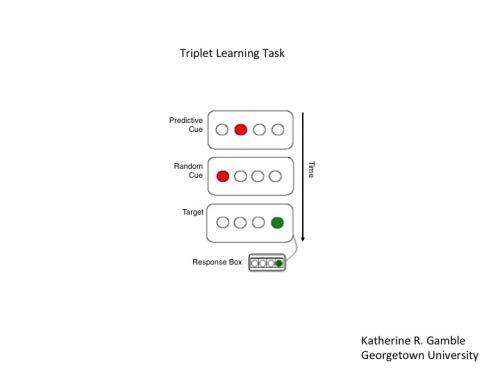Simple dot test may help gauge the progression of dopamine loss in Parkinson's disease

A pilot study by a multi-disciplinary team of investigators at Georgetown University suggests that a simple dot test could help doctors gauge the extent of dopamine loss in individuals with Parkinson's disease (PD). Their study is being presented at Neuroscience 2013, the annual meeting of the Society for Neuroscience.
"It is very difficult now to assess the extent of dopamine loss—a hallmark of Parkinson's disease—in people with the disease," says lead author Katherine R. Gamble, a psychology PhD student working with two Georgetown psychologists, a psychiatrist and a neurologist. "Use of this test, called the Triplets Learning Task (TLT), may provide some help for physicians who treat people with Parkinson's disease, but we still have much work to do to better understand its utility," she adds.
Gamble works in the Cognitive Aging Laboratory, led by the study's senior investigator, Darlene Howard, PhD, Davis Family Distinguished Professor in the department of psychology and member of the Georgetown Center for Brain Plasticity and Recovery.
The TLT tests implicit learning, a type of learning that occurs without awareness or intent, which relies on the caudate nucleus, an area of the brain affected by loss of dopamine.
The test is a sequential learning task that does not require complex motor skills, which tend to decline in people with PD. In the TLT, participants see four open circles, see two red dots appear, and are asked to respond when they see a green dot appear. Unbeknownst to them, the location of the first red dot predicts the location of the green target. Participants learn implicitly where the green target will appear, and they become faster and more accurate in their responses.
Previous studies have shown that the caudate region in the brain underlies implicit learning. In the study, PD participants implicitly learned the dot pattern with training, but a loss of dopamine appears to negatively impact that learning compared to healthy older adults.
"Their performance began to decline toward the end of training, suggesting that people with Parkinson's disease lack the neural resources in the caudate, such as dopamine, to complete the learning task," says Gamble.
In this study of 27 people with PD, the research team is now testing how implicit learning may differ by different PD stages and drug doses.
"This work is important in that it may be a non-invasive way to evaluate the level of dopamine deficiency in PD patients, and which may lead to future ways to improve clinical treatment of PD patients," explains Steven E. Lo, MD, associate professor of neurology at Georgetown University Medical Center, and a co-author of the study.
They hope the TLT may one day be a tool to help determine levels of dopamine loss in PD.
















